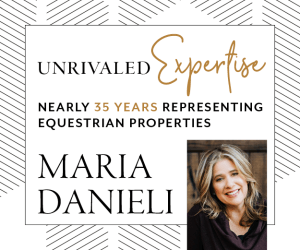Survey Before Building Can Avoid Expense and Stress Later
By Allison Trimble
Equestrian properties often exist on land that has been long established. Fences, barns and structures have been in place for decades or longer. Property lines are nearly always indicated by boundary fencing and have been accepted by neighbors for years. The problem commonly arises when a property is sold or being developed, and a survey is completed.
The findings of a survey can be so shocking as to find that part of a house or barn is on the adjacent property. Most often a fence line or driveway is located on the wrong side of the surveyed line. A recent situation I encountered was an estate sale with the neighboring property being owned by a portion of the estate’s trust. The short plat was not surveyed in the 1970’s when it was recorded, the driveway was put in about 15 feet outside of the specified driveway easement, and the property line was about 23 feet off from where it would have been if the driveway had been put in properly.
When something like this occurs, it nearly always results in a boundary line dispute. This can become a very nasty and costly situation. One party has been using a property as it is for generations but the other party has a survey saying the property is theirs. The situation is rarely between neighbors who have coexisted harmoniously for years. So, what happens now?
Adverse Possession is a legal doctrine that allows a person to claim a property right for land owned by another. There are standards that must be met, varying in statute between states, but always requiring that the use be open and notorious, exclusive, hostile and continuous and uninterrupted. In Washington State this is RCW 7.28.070 and reads: Every person in actual, open and notorious possession of lands or tenements under claim and color of title, made in good faith, and who shall for seven successive years continue in possession, and shall also during said time pay all taxes legally assessed on such lands or tenements, shall be held and adjudged to be the legal owner of said lands or tenements, to the extent and according to the purport of his or her paper title. All persons holding under such possession, by purchase, devise or descent, before said seven years shall have expired, and who shall continue such possession and continue to pay the taxes as aforesaid, so as to complete the possession and payment of taxes for the term aforesaid, shall be entitled to the benefit of this section.
Prescriptive Easement differs from adverse possession in that it refers to the use of the property, not possession. An example of this would be a property owner has used a driveway for access to a property for a lengthy period of time and the usage was substantial enough for a court to grant a prescriptive easement. Generally, the same statutory requirements apply here as do with adverse possession.
Important to know is that both doctrines require legal action to bring to fruition. The burden of proof is on the party bringing the claim to the court, and this can be a costly and lengthy process.
I often find that there can be a solution found between parties that is swifter, fairer, and less costly. I would always suggest that a landowner’s first step is to consult a land-use attorney to determine the strength of their position and to weigh out all the options and potential costs. In my most recent situation, the parties agreed to leave the boundary line as it was, survey and adjust the easement for the driveway access and granted permission for the use of the property between the driveway and the property line, keeping the acreage of both properties the same, and still continuing the existing usage.
I find that property owners on both sides of the dispute tend to feel their position is solid, but it’s never quite that simple. What’s important to understand when dealing with legal doctrines is that ultimately, it will be decided by a court. The takeaway from this is to be ever vigilant about one’s own property boundaries and rights, and when placing fences or buying property, to strongly consider taking the expense of a boundary survey before acting. It could save a lot of stress and money in the future.
Published September 2018 Issue

Allison Trimble is a Realtor® specializing in equestrian properties, farm and ranch properties, and residential real estate. As a former horse trainer, and a current owner, breeder and non-pro competitor in cow horse and reining events, she combines her experience in the horse industry with her lifelong real estate expertise to guide her clients through the real estate process.
Learn more at www.coastalrealtywa.com





